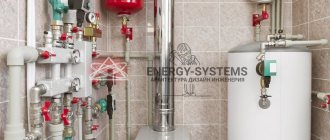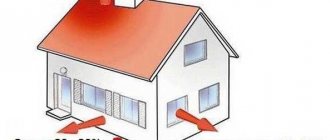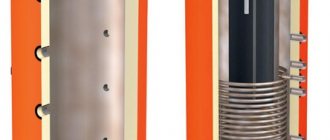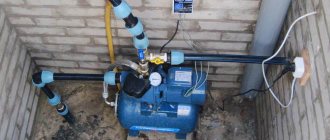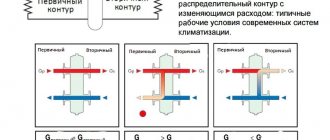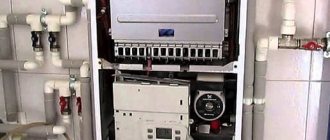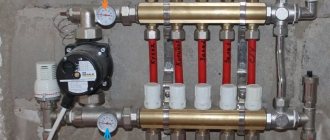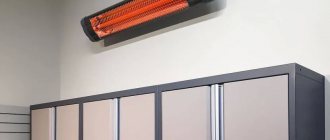Weak boiler power will ruin everything, including the standard of living. Due to excess power, the system will operate in impulses: fuel consumption will increase, and the service life of the equipment will be shortened. The boiler may boil. Or brains. How to calculate correctly, what parameters to take into account, what heat loss is and other customer questions about boiler power can be read here.
How to easily calculate the power of a heating boiler?
You can calculate the approximate power of a boiler for a home by area and volume .
1) A simplified version of calculations by area : 10 kW per 100 m² of a house (or heated area). And this figure will only show the minimum power, below which you cannot fall.
| Graph of boiler versus area |
To take into account climatic zones, coefficients have been developed that correct this formula:
- Central Russia is 1-1.5;
- Northern regions are 1.5-2;
- Southern territories – 0.7-0.9;
- Moscow and Moscow region – 1.2-1.5.
To get closer to a realistic figure, you also need to take into account possible heat loss. To do this, add 10-15% to the minimum value. If the ceilings are higher than 2.7 meters, then we divide the actual ceiling height by the standard height. We get another correction factor.
| Vacation home |
Example:
Let's calculate the power of a boiler for a house in the Moscow region. Ceilings – 3 meters, area – 150 m². A double-circuit boiler is needed - for heat and hot water supply.
The formula gives 15 kW - the minimum power value for the future boiler. Next, to the number 15 we add 10% of heat loss, multiply by the climate coefficient 1.2. The ceilings are higher than 2.7m, so we multiply the resulting figure by a factor of 1.1.
Boiler power = 15 kW (minimum) + 10% (heat loss) * 1.2 * 1.1 = 21.7, rounded to 22 kW.
2) Second formula based on volume : 1 m3 – 40 W. Plus the markups that were included in the first formula, except for the ceiling coefficient. Let's calculate the same house in the Moscow region using this formula.
Boiler power =((150 m²*3m)* 40 W + 10%) * 1.2 * 1.1 =23522 W ≈ 24 kW. The difference between the first and second calculations is 2 kW. The option of calculating boiler power by air volume is the most correct.
You could stop reading this article here. But the difference between an approximate and an exact calculation is in several nuances. What are the nuances, you ask. The answer to this question is contained in the following paragraphs.
General points
In order for the house to be warm, the heating system must replenish all existing heat losses in full. Heat escapes through walls, windows, floors, and roofs. That is, when calculating the boiler power, it is necessary to take into account the degree of insulation of all these parts of the apartment or house. With a serious approach, they order a calculation of the building’s heat loss from specialists, and based on the results, they select the boiler and all other parameters of the heating system. This task is not to say that it is very difficult, but it is necessary to take into account what the walls, floor, ceiling are made of, their thickness and the degree of insulation. They also take into account the cost of windows and doors, whether there is a supply ventilation system and what its performance is. In general, a long process.
There is a second way to determine heat loss. You can actually determine the amount of heat that a house/room loses using a thermal imager. This is a small device that displays the actual picture of heat loss on the screen. At the same time, you can see where the outflow of heat is greater and take measures to eliminate leaks.
Determining actual heat loss - an easier way
Now let’s talk about whether it’s worth taking a boiler with a power reserve. In general, constant operation of equipment at the limit of its capabilities negatively affects its service life. Therefore, it is advisable to have a performance reserve. Small, about 15-20% of the calculated value. It is quite enough to ensure that the equipment does not work at the limit of its capabilities.
Too much stock is not economically profitable: the more powerful the equipment, the more expensive it is. Moreover, the price difference is significant. So, if you are not considering the possibility of increasing the heated area, you should not take a boiler with a large power reserve.
What parameters, besides volume and area, influence the choice of boiler? And why is this important?
A simplified calculation formula often leads to the purchase of an unsuitable boiler. Each house is individual, and heat loss percentage cannot be equal for all houses. Before calculating power, consider the data of a specific house:
1) Measure the area of walls, windows, doors;
2) Specify the thickness of the walls, indicate the type of finishing and material, the height of the ceilings;
3) Observe the minimum temperature of the house in cold weather;
4) Determine the desired temperature as a result of installing the boiler;
5) Write down the thermal conductivity values for the materials from which the house was built.
| Wall material | Wall thickness and material thermal resistance | Required thickness for home |
| Brick (1600 kg/m³ - density) | 510 mm (if laying two bricks), R=0.73 °C m²/W | 1380 mm 2190 mm |
| Wooden beam | 150 mm, R=0.83 °С m²/W | 355 mm 565 mm |
| Expanded clay concrete (1200 kg/m³ - density.) | 300 mm, R=0.58 °С m²/W | 1025 mm 1630 mm |
| Wooden panel (inside filled with mineral wool + 25 mm layer of inner and outer cladding) | 150 mm, R=1.84 °С m²/W | 160 mm 235 mm |
| Arbolit | 0.80-0.17W/m² | — |
| Foam concrete | 0.14-0.38 W/m² | — |
| Aerated concrete | 0.18-0.28 W/m² | — |
Thermal resistance of materials
Why is this necessary? The key parameter influencing the choice of boiler is the heat loss of the house. Houses with the same area and volume, but different degrees of insulation, will require equipment of different power.
Where does the heat go:
| Surface | Heat loss in% |
| Roof and ventilation | 20-25% |
| Foundation, if it is adjacent to the ground | up to 15% |
| Walls, windows and doors | 10-15% |
| Ground floor and unheated rooms, basement, for example | up to 15% |
It also matters: how different the outside temperature is from the inside, the climatic region, the strength and direction of the wind, how the house stands relative to parts of the world.
| Heat loss |
Boiler heat transfer - why calculations are needed
The heating system must completely compensate for all heat loss in the house, which is why the boiler power is calculated. The building constantly releases heat to the outside. Heat loss in a house varies and depends on the material of the structural parts and their insulation. This affects the calculated performance of the heat generator. If you take the calculations as seriously as possible, you should order them from specialists; based on the results, a boiler is selected and all parameters are calculated.
It is not very difficult to calculate heat loss yourself, but you need to take into account a lot of data about the house and its components, and their condition. An easier way is to use a special device for detecting heat leaks - a thermal imager. The screen of a small device displays not calculated, but actual losses. It clearly shows the location of leaks, and measures can be taken to eliminate them.
Or maybe no calculations are needed, just take a powerful boiler and the house will be provided with heat. Not so simple. The house will really be warm and comfortable until it’s time to think about something. The neighbor has the same house, the house is warm, and he pays much less for gas. Why? He calculated the required boiler output, which is one third less. The understanding comes that a mistake has been made: you should not buy a boiler without calculating the power. Extra money is spent, some of the fuel is wasted and, what seems strange, an underloaded unit wears out faster.
A boiler that is too powerful can be reloaded for normal operation, for example, by using it to heat water or by connecting a previously unheated room.
Heating system
A boiler with insufficient power will not heat the house and will constantly work with overload, which will lead to premature failure. And it will not only consume fuel, but eat it, and still there will not be good heat in the house. There is only one way out - install another boiler. Money went down the drain - buying a new boiler, dismantling the old one, installing another - everything is not free. And if we also take into account the moral suffering due to a mistake made, perhaps the heating season experienced in a cold house? The conclusion is clear - you cannot buy a boiler without preliminary calculations.
How to calculate power taking into account heat loss?
What is heat loss? Let’s say it’s -20 degrees outside, but the average temperature at home is +20 degrees. These quantities are balanced through the exchange of energy. Heat losses occur. The amount of heat loss under severe weather conditions helps to calculate the boiler power with high accuracy.
Step 1
Heat loss is determined by the formula: Q = Q roof + Q walls + Q floor + Q doors + Q windows .
Where the extreme value of Q is the heat loss of each surface of the house.
Each Q value is calculated using the formula: Q = S * T / R
Where Q is heat loss in W, S is the area of a specific surface in m², T is the difference between street and room temperatures in degrees, R is reference data on thermal resistance by type of material.
Step 2
This formula additionally includes involuntary heat loss through cracks, ventilation, exhaust hoods, opening doors and ventilation through windows. For independent calculations without a program, an additional 5% of the total leakage figure is added.
Step 3
Next we move on to determining the boiler power. There are only two formulas to choose from:
Rkot. = ( S room * P beat ) / 10 , where Rkot. — boiler power, Sroom. - the total area of rooms in the house where heating is planned, Pud. — specific power according to climate conditions.
Rkot. = ( Q losses * S from area ) / 100, where Rkot. - boiler power, Qloss - heat loss, Sot. area – total area of heated rooms.
Step 4
For an electric and gas boiler, you can use the table to check:
| Option | House area, m² | Heating, kW | Recommended number of devices | How many people live | DHW boiler, l/kW | Warm floor, m² | Warm floor, kW | Total power | Boiler power | Standard range of boilers, Cat, Ns/A/Nd |
| 1 | 2 | 3 | 4 | 5 | 6 | 7 | 8 | 9 | 10 | 11 |
| 2 | 150 | 19 | 10 | 4 | 100/28 | 16 | 0,75 | 48 | 28 | 28/27/28 |
| 3 | 200 | 22 | 11 | 4 | 100/28 | 20 | 1 | 51 | 28 | 28/27/28 |
| 4 | 250 | 25,5 | 17 | 4 | 160/33 | 20 | 1 | 60 | 33 | 32/35/36 |
| 5 | 300 | 27 | 20 | 6 | 160/33 | 30 | 1,5 | 62 | 34 | -/35/36 |
| 6 | 350 | 31 | 26 | 6 | 200/33 | 40 | 2 | 66 | 39 | -/44/44 |
| 7 | 400 | 4 | 30 | 6 | 200/36 | 50 | 2,5 | 70 | 43 | -/44/44 |
| 8 | 450 | 36 | 44 | 8 | 300/36 | 60 | 3 | 75 | 45 | -/53/52 |
Heat loss accounting
Without taking into account heat loss, it is difficult to correctly calculate the boiler power
. When starting to develop an autonomous heating system, you must first find out how much heat is lost to the street during the most severe frosts through the so-called enclosing structures. These include walls, windows, floors and roofs. Only after determining the amount of heat loss will it be possible to worry about selecting a heat source of appropriate power. It should be taken into account that the loss of heat from a building in the winter season occurs not only through the enclosing structures. A significant part of the generated heat (up to 30%) is spent on heating cold air coming from the street due to natural ventilation.
The total amount of heat required to heat the room is determined by the formula:
Q = Qdesign + Qair, where:
- Qconstruct – the amount of heat lost through a similar structure, W;
- Qair – the amount of heat consumed to heat the air coming from the street, W.
By summing up the values obtained as a result of calculations, the total heat load on the heating system of the entire building is determined.
All measurements are carried out on the outside of the building, necessarily taking into account its corners. Otherwise, the calculation of heat loss will be inaccurate.
There are other ways of heat leakage in rooms, for example, through a kitchen hood, open doors and windows, cracks in structures, etc. However, the amount of heat lost for these reasons practically does not exceed 5% of the total heat loss and is therefore not taken into account in calculations .
Calculation of heat loss through building envelopes
The complexity of the calculation lies in the fact that it must be carried out for each room separately, carefully inspecting, measuring and assessing the condition of each of its elements adjacent to the environment. Only in this case can you take into account all the heat leaving the house.
Based on the results of the measurements, the area S of each element of the enclosing structure is determined, which is then inserted into the basic formula for calculating the amount of lost thermal energy:
Qconstruct = 1/R*(Tv-Tn)*S*(1+Σβ), R = δ/λ; Where:
- R – thermal resistance of the construction material, m sq.°C/W;
- δ – thermal conductivity of the construction material, W/m°C);
- λ – thickness of the construction material, m;
- S – area of the external fence, sq. m.;
- Tb – indoor air temperature, °C;
- Tn – lowest air temperature in winter, °C;
- β – heat loss, which depends on the orientation of the building.
If the structure consists of several materials, for example, a brick wall with insulation, the value of thermal resistance R is calculated separately for each of these materials and then summed up.
Heat losses, depending on the orientation of the building, are selected based on where the enclosing element is oriented:
- to the north side – β = 0.1;
- to the west or southeast – β = 0.05;
- to the south or southwest – β = 0.
The calculation of heat losses through the elements of the building envelope is carried out for each room in the building, and then summing them up, the predicted value of the total heat losses in it is obtained. After this, they proceed to the calculation in the next room. As a result of the work carried out, the home owner will be able to identify ways of maximum heat leakage and eliminate the causes of their occurrence.
Calculation of heat consumed to heat ventilation air
The amount of heat that is spent on heating ventilation air reaches, in some cases, 30% of the total thermal energy losses. This is a fairly large value that is inappropriate to ignore. To calculate the amount of heat that will be forced to be spent on heating the supply air, the formula is used:
Qair = c*m* (Tv-Tn), where:
- c is the heat capacity of the air mixture, the value of which is 0.28 W/kg°C;
- m – mass flow of air entering the room from the street, kg.
The mass flow of air entering the room from the outside is determined by assuming that the air is renewed throughout the entire house once every hour. In this case, by adding up the volumes of all rooms, the volumetric air flow rate is obtained. Then, using the air density value, its volume is converted to mass. Here you need to take into account the fact that the density of air depends on its temperature.
| Supply air temperature ºС | — 25 | — 20 | — 15 | — 10 | -5 | 0 | + 5 | + 10 |
| Density, kg/m3 | 1,422 | 1,394 | 1,367 | 1,341 | 1,316 | 1,290 | 1,269 | 1,247 |
Substituting all known quantities into the above formula, the amount of heat required to heat the supply air is determined.
Common mistakes
Calculation of an autonomous heating system is a complex process consisting of several interrelated, step-by-step procedures:
- Calculation of heat losses of an object.
- Determination of the temperature regime of individual rooms and the building as a whole.
- Calculation of the power of heating radiator batteries.
- Hydraulic calculation of the heating system.
- Calculation of heating boiler power.
- Determination of the total volume of the autonomous heating system.
Thermal calculation of a heating system is not theoretical research, but an accurate and well-founded result, the practical implementation of which will allow you to correctly select all the necessary components and set up an effective heating system that functions without problems for many years.
The main mistake that many owners of private houses make is ignoring some stages of the calculation. They believe that to solve the problem it is enough to choose a more powerful boiler, focusing only on the data of the approximate calculation of its power based on the area of the room. This approach threatens with unnecessary operating costs and often leads to the fact that the boiler will work constantly, the radiator batteries will be hot, and the room will be cold. In this case, it is necessary to return to the original state and perform a full calculation of the heating system. Only after this can we begin to eliminate the shortcomings caused by critical errors in calculations.
Why count if you can buy a boiler with a power reserve?
Sometimes boilers have a capacity reserve. This is good when the reserve is no more than 25%. Especially when the family plans to develop the area: complete a swimming pool, sauna, or other heated area. When the required power is exceeded significantly, the owner spends extra money, and the equipment operates in abnormal mode:
| Boiler repair |
- Breaks or malfunctions;
- The efficiency of the system decreases;
- A higher power boiler costs more;
- More fuel is consumed than is required to heat the house;
- A more powerful and expensive pump will be needed;
- The house will be very hot;
- Automatic regulation becomes difficult, the boiler may boil;
- The boiler begins to cycle - it turns on and off in a short period of time, equipment components wear out;
- Condensation appears in the chimney. When burned, the condensate reacts with the emissions and produces acid. It destroys the chimney and sometimes the boiler.
Conclusion: frequent switching on and off wastes more fuel than continuous operation. Buying a boiler with excess power not only makes no sense, but is also harmful to the budget and equipment.
Scheme 2: according to housing characteristics
An electric boiler does not always exactly match the heating energy needs of a home. Often its power is selected with a reserve. Here are some examples of such scenarios:
A dual-circuit device provides the house with hot water;
The power of a double-circuit boiler is excessive, since it must provide the house with hot water. Including during the heating season.
- It is planned to add additional rooms to the house with the connection of heating devices in them to the existing circuit;
- The region is characterized by rare but severe frosts, and the heating system is designed specifically for them.
The photo shows winter Sevastopol. Even in warm regions there are severe frosts. The heating system has to be designed with a safety margin.
If the boiler power is obviously excessive, you will have to focus not on it, but on the actual heat consumption of the house. Most accurately, it can be calculated using the formula Q=V*Dt*k/860.
We invite you to read why batteries do not heat up in a private house
The variables in this formula from left to right are:
- Energy consumption (kW);
- The volume of the room that needs to be heated. It is indicated in SI units - cubic meters;
- Difference between indoor and outdoor temperatures;
- Insulation coefficient.
Where do I get the last two parameters?
The temperature delta is taken equal to the difference between the sanitary norm for the room and the coldest five days of winter.
| Description | Temperature norm, C |
| A room in the center of the house, the lowest winter temperature is above -31C | 18 |
| A room in the center of the house, the lowest winter temperature is below -31C | 20 |
| Corner or end room, lower winter temperature above -31C | 20 |
| Corner or end room, lower winter temperature below -31C | 22 |
| City | Value, C |
| Khabarovsk | -29 |
| Surgut | -43 |
| Smolensk | -25 |
| Saint Petersburg | -24 |
| Saratov | -25 |
| Petrozavodsk | -28 |
| Permian | -25 |
| Eagle | -25 |
| Omsk | -37 |
| Novosibirsk | -37 |
| Murmansk | -30 |
| Moscow | -25 |
| Magadan | -29 |
| Kemerovo | -39 |
| Kazan | -31 |
| Irkutsk | -33 |
| Ekaterinburg | -32 |
| Volgograd | -22 |
| Vladivostok | -23 |
| Vladimir | -28 |
| Verkhoyansk | -58 |
| Bryansk | -24 |
| Barnaul | -36 |
| Astrakhan | -21 |
| Arkhangelsk | -33 |
Distribution of winter temperatures across Russia.
The insulation coefficient can be selected from the following range of values:
- A house with an insulated facade and triple glazing - 0.6-0.9;
- Two-brick walls without insulation and double-glazed windows - 1-1.9;
- Brick walls and single-strand glazed windows - 2 - 2.9.
Example
House size: 6x8x3 meters.
Climatic zone: Sevastopol, Crimea peninsula (the temperature of the coldest five-day period is -11C).
Insulation: single glass with high thermal conductivity, walls made of rubble stone half a meter thick.
A rubble house with single glazing requires intense heating in winter.
We also went through the technique of further calculations:
- The boiler will consume an average of 5.5*24=132 kWh per day;
- It will consume 132*30=3960 kilowatt-hours of electricity per month.
If the average power of the boiler is known, it is not a problem to calculate how much the device consumes per month and over the entire winter.
Example
Let's find out, as an example, how much energy is needed for a boiler with a rated power of 12 kilowatts:
- Its average power is 12/2=6 kW;
- Consumption per day - 6*24=96 kilowatt-hours;
- Heating will consume 96*30=2880 kWh per month;
- Electricity consumption during the winter with a heating season of 180 days (from October 15 to April 15) will be 180*96=17280 kWh.
The length of the heating season in your region can be found on this map. The heating turns on when the air temperature drops below 8 and turns off when the temperature rises above 8.
Now let's do one more calculation - find out how much heating will cost. I use data for a single-rate tariff in Sevastopol as of January 2022:
- When consuming up to 150 kWh per month, a social tariff of 2.42 rubles applies;
- In the range of 150 - 600 kilowatt-hours per month, the price increases to 2.96 rubles;
- Electricity above 600 kWh per month costs pennies.
Current electricity tariffs. Sevastopol, first half of 2022.
Total 12312 1332 363 = 14007 rubles.
When using a single-tariff meter, electric heating will cost a pretty penny.
Switching to mains gas will greatly reduce your home heating costs.
How to solve the problem of high power and weak demand?
In an ideal situation, the boiler operates at a constant, rated output. At the same time, the outside temperature is constantly changing, and there are even abnormal jumps. What to do? Four-way mixing valves in the hydraulic system will help. Or an option with thermo-hydraulic distribution. These devices solve the problem not by adjusting the boiler power, but by adjusting the control valve. Or the speed of the circulation pump changes. The temperature of the coolant in the batteries becomes comfortable without disturbing the optimal conditions of the boiler. This solution has a minus - a high price.
| Four way mixing valve |
For gas and liquid fuel boilers, multi-stage burners solve this situation. A lower stage reduces the boiler power if necessary. Advanced models have a smooth adjustment of burner power - modulation. It is cheaper and not as troublesome as the first option.
| Multi-stage gas burner |
Solid fuel boilers also have built-in power settings and automatic fuel supply. This helps solve the issue of excess power when the external temperature changes.
| Automatic fuel supply device for liquid-heat boiler |
Determining the number of radiators for single-pipe systems
There is another very important point: all of the above is true for a two-pipe heating system, when a coolant with the same temperature enters the input of each radiator. A single-pipe system is considered much more complex: there, increasingly colder water flows to each subsequent heating device. And if you want to calculate the number of radiators for a one-pipe system, you need to recalculate the temperature every time, and this is difficult and time-consuming. Which exit? One of the possibilities is to determine the power of the radiators as for a two-pipe system, and then, in proportion to the drop in thermal power, add sections to increase the heat transfer of the battery as a whole.
In a single-pipe system, increasingly colder water flows to each radiator
Let's explain with an example. The diagram shows a single-pipe heating system with six radiators. The number of batteries was determined for two-pipe wiring. Now we need to make an adjustment. For the first heating device everything remains the same. The second one receives coolant with a lower temperature. We determine the % drop in power and increase the number of sections by the corresponding value. In the picture it turns out like this: 15kW-3kW=12kW. We find the percentage: the temperature drop is 20%. Accordingly, to compensate, we increase the number of radiators: if 8 pieces were needed, there will be 20% more - 9 or 10 pieces. This is where knowing the room will come in handy: if it’s a bedroom or a children’s room, round up, if it’s a living room or other similar room, round down
You also take into account the location relative to the cardinal points: in the north you round up, in the south you round down.
In single-pipe systems, it is necessary to add sections to radiators located further along the branch
This method is clearly not ideal: after all, it turns out that the last battery in the branch will have to be simply enormous in size: judging by the diagram, a coolant with a specific heat capacity equal to its power is supplied to its input, and in practice it is unrealistic to remove all 100%. Therefore, usually when determining the power of a boiler for single-pipe systems, they take a certain reserve, install shut-off valves and connect radiators through a bypass so that the heat transfer can be adjusted and thus compensate for the drop in coolant temperature. One thing follows from all this: the number and/or size of radiators in a single-pipe system must be increased, and more and more sections must be installed as you move away from the beginning of the branch.
What happens if you buy a boiler of lower power?
When the owner made a mistake with the power on the smaller side, this is just as bad as an oversupply. The system is working at its limit. Service life is reduced. The house is not heated sufficiently; the system may freeze during abnormal frosts.
| Freezing of the heating system |
What electrical requirements should you pay attention to?
Before connecting the electric boiler, you need to pay attention to the electrical requirements
- How many watts of voltage can your home's current network handle? In particular, the voltage in rural areas is not 210-230 V, but only 150-180 V. Specific types of imported boilers at this voltage may simply not start.
- What power is allocated to your series of houses or to the village in which you live. For example, if your dacha community includes 60 houses, and electricity is allocated at the rate of 5 kW per house, then in the process of installing a boiler with a power of 30 kW you will certainly have disagreements with your neighbors. How much power is allocated to your home? Modern dacha communities very often install a 10-12 kW automatic machine in order to avoid quarrels with their neighbors.
- It is worth checking the current condition of the transformer installed in your village. In some cases, it is necessary to pull certain wires to connect the electric boiler.
- Find out what powerful electrical appliances your neighbors have installed and whether their total power will drop below that allocated for the house.
If all requirements are met, you can install an electric boiler or convector.
The energy consumption to ensure heating of 1 m 3 of volume is used by an electric boiler and a convector approximately equal. Date: September 25, 2022
Why contact a specialist?
We found out that buying a boiler from the square is wrong. It is important to consider the heat loss of the building. For example, a house of 300 m² can be heated by a 15 kW boiler if all surfaces are thoroughly insulated. And a house of 150 m² may require 30 kW equipment with thin walls and uninsulated roof and ventilation.
There are hundreds of standards and regulations on this topic, there are dozens of formulas. Sometimes one thing contradicts the other, or standards change and it is difficult for a non-professional to understand whether these requirements are relevant. You can calculate all this armed with a stack of reference books. Or contact specialists who will make accurate calculations in the program and explain all the details. They will help you save money, time, and model an efficient home heating system.
Solid fuel boilers
Solid fuel heat generators are presented in three varieties - direct combustion, pyrolysis and pellet.
The popularity of this type of equipment is explained by the low cost of operation, since firewood and coal are an order of magnitude cheaper than other types of energy resources. Natural gas in Russia stands apart here: however, if you calculate all the costs of connecting it, then the amount of money required for this is sometimes enough to purchase and install a heating boiler in a private house. This is why coal and wood fired boilers are so popular. There is also the other side of the coin - such equipment functions like traditional stoves. Harvesting and loading firewood will require a lot of effort. To ensure the durability and safety of a solid fuel boiler, you will need high-quality piping. It's all about inertia, when even after closing the damper, water heating continues for some time. To achieve a good effect in using the generated energy, it is necessary to install a heat accumulator.
For solid fuel boilers, high efficiency is rare: the average efficiency here is usually 75%. Pyrolysis and pellet models are slightly more efficient - 80-83%. Pellet-based equipment is considered the most comfortable, as it is characterized by good automation and an almost complete absence of inertia. There is no need for a heat accumulator or frequent fuel loading. The only drawback is the high cost of pellet boilers.
How does an electric boiler work?
In order to choose the right electric boiler for heating your home, you need to know its characteristics and make sure that they meet the network requirements. Any electric heating boiler for a home includes the following elements:
- Frame. The outer shell, inside which all the boiler parts are assembled;
- Heat exchanger. Heater and container with coolant;
- Control block. Process control, monitoring and regulation system.
Diagram of an electric boiler with a heating element
Approximate selection of boiler
For example, for heating a home with a total area of 350 m2, located in the Moscow region, the calculation will be as follows: W = S * Wud/10 = 350 * 1.35/10 = 47.25 kW. In the example, the resulting figure should be rounded, it turns out that you need to select a device with a power of about 50 kW.
Another example. Determination of power for a house with an area of 230 m2 located in the north of Russia: W = S * W beats/10 = 230 * 1.7/10 = 39.1 kW. In this case, you need to select a device based on the value of 39.1 kW, which when rounded will be equal to 40, but you need to take a power reserve, so you can use 43.
The calculation is simple and does not require professional knowledge. You just need to take into account the initial parameters of the room, take the correct value of the specific force W beat relative to the climate zone.
What boiler are you planning to buy for a private home?
Gas
Electric
Which electric boiler is best for heating a private home?
The popularity of electric boilers is determined by:
- security;
- low cost;
- reliability;
- small in size;
- ease of installation and operation;
- silent operation;
- environmental cleanliness.
To choose and buy the best electric boiler, you need:
- make calculations and determine the required power;
- decide on the type of boiler;
- compare options of the selected type and select the best one.
Let me remind you that before purchasing, you must definitely check the operating mode of the local electrical networks - perhaps the networks will not cope with the required load, and the purchase will be in vain.
When deciding which electric boiler to choose for heating a private home, most consumers choose heating element boilers. They are much cheaper than electrode and induction boilers and are easy to maintain. Judging by customer reviews, the best electric boilers on the Russian market for heating a private home are:
- Polish units “KOSPEL EKCO” with an efficiency of more than 99%. Boilers from this manufacturer are used for radiator heating and can work together with water heaters for hot water supply. The company offers manual models for small rooms, and automatic three-phase models of boilers with a power of more than 50 kW for large rooms. The disadvantage of boilers is typical for heating equipment - scale formation on the heating elements. According to customer reviews, boilers from this manufacturer are very economical and reliable.
- Russian electric boilers are also popular in the domestic market. Boilers of three power levels from this manufacturer operate from a conventional and three-phase network, and, according to customer reviews, are quite reliable.
- Electrode boilers have also proven themselves well. They are more economical than heating elements and allow you to do without thermal elements. The most popular boiler of this group is considered to be the Geyser model, whose power ranges from 9 to 15 kW. Low-power “Ochag” models and large “Vulcan” boilers with a power of up to 50 kW are also known on the market. The disadvantages of such boilers are the risk of electric shock and the mandatory involvement of a specialist to replace the electrodes.
- Induction boilers are represented by Russian models “SAV” from INERA. The price for such equipment is high - from 30 to 160 thousand rubles, which depends on the power (for induction boilers it is 2.5 - 100 kW).
The photo shows a Polish electric boiler “KOSPEL EKCO.R1-6”
Adjustment of calculations
Most of the residential premises with average indicators are quite rare, so it is necessary to adjust the calculations.
The characteristic when determining the “W” indicator is the level of heat loss. This phenomenon is inherent in any house, regardless of what it is built from or how much it is insulated. If the walls of the house are insulated with conventional material, then heat loss can reach 35 percent, another 10 percent will go to the windows. A floor without insulation can lose up to 15 percent, and a roof up to 25.
When performing calculations, the following values are used and multiplied by the calculated power:
- A modern house with good insulation: K=0.6;
- With non-insulated walls and roof: K=1.8;
- There is no wall insulation: K=1.5;
- A house made of wood, brick or foam block, which is over 15 years old, with good insulation: K=1.
Returning to the calculations carried out above, where the boiler power is defined as 50 kilowatts, assuming that the house is of a modern type and well insulated, we get: 50 * 0.6 = 30 kW.
In the second example, the value obtained is 43 kilowatts, for which we get: 43 * 1.5 = 64.5 kW (rounded to 65). The initial data was considered to be the location of the house in the north of the country; accordingly, up to 20 percent should be added to the obtained value, since there are severe frosts in the north in winter, the figure will be 78.
Scope of application of modern electric boilers
There is an opinion that electric boilers can sufficiently heat only small houses. Such a statement is erroneous, since manufacturers produce not only low-power electric boilers, but also units that provide a comfortable stay in buildings with an area of up to 1000 square meters. They are usually used as backup equipment if the main system fails because the cost of electricity is high.
Low-power boilers, which are three-phase and single-phase, are installed in small houses. Devices with a power of more than 6 kW are also produced in multi-stage versions, with their help you can significantly save on electricity bills (read: “Economical electric boilers for home heating: types”). Knowledge of how to calculate the power of an electric boiler allows you to purchase equipment that will meet the necessary criteria.

